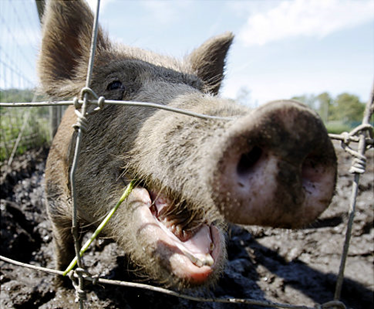Inadequate Enrichment

What To Look For:
Look out for a low proportion of pigs rooting around in soil or straw compared with proportion rooting or chewing on fittings in the paddock (posts, pipes, etc.) or interacting agonistically with other pigs (eg chewing on ears or tails, fighting – interacting in a way that gets a negative reaction from the other pig such as walking away, squealing or retaliating).
Outdoor systems are generally considered to provide the most natural rooting and chewing opportunities for pigs, eg turf, soil, insects, stones, as well as a greater range of temperatures, choice of environments, light levels, etc. However, especially in paddocks where pigs have been regularly housed, the “interest” in soil may be reduced, eg if soil is dry or dusty, or has high percentage of faeces.
There is still no definitive interpretation of the use of pebbles by outdoor pigs and whether or not stone chewing is a sign of good or poor conditions. Tooth and stomach damage have been attributed to stone chewing (even if pigs are choosing to use the stones as enrichment) – provision of less harmful enrichment materials that fulfil more of the pigs’ needs is likely to be more beneficial.
Additional information:
Look out for a low proportion of pigs rooting around in soil or straw compared with proportion rooting or chewing on fittings in the paddock (posts, pipes, etc.) or interacting agonistically with other pigs (eg chewing on ears or tails, fighting – interacting in a way that gets a negative reaction from the other pig such as walking away, squealing or retaliating).
Outdoor systems are generally considered to provide the most natural rooting and chewing opportunities for pigs, eg turf, soil, insects, stones, as well as a greater range of temperatures, choice of environments, light levels, etc. However, especially in paddocks where pigs have been regularly housed, the “interest” in soil may be reduced, eg if soil is dry or dusty, or has high percentage of faeces.
There is still no definitive interpretation of the use of pebbles by outdoor pigs and whether or not stone chewing is a sign of good or poor conditions. Tooth and stomach damage have been attributed to stone chewing (even if pigs are choosing to use the stones as enrichment) – provision of less harmful enrichment materials that fulfil more of the pigs’ needs is likely to be more beneficial.
Suggestions:
Suggested actions that can be taken are:
- Replenish (or replace) straw in the lying area, and in fair weather add bales to the paddock. Adding enrichment to less-used areas of the paddock can help distribute the pigs around the paddocks, and also provide temporary shade or shelter
- Add large logs or branches (non-poisonous species). These can also add shade and variety
- Suspend large objects (eg wellingtons, traffic cones, branches, plastic barrels) from secure paddock fittings (eg shelters)
- Add large turfs (from known sources, ie pig-free (or on-site), not from areas likely to be accessed by dogs or cats
- Add new soil to the paddock eg sterilised spent mushroom compost
- Add novel substrate eg wood shavings
If the majority of rooting pigs show more interest in the objects or novel substrates after a period of several weeks, this suggests that the soil composition is no longer keeping them interested enough.
Additional material:
N/A
